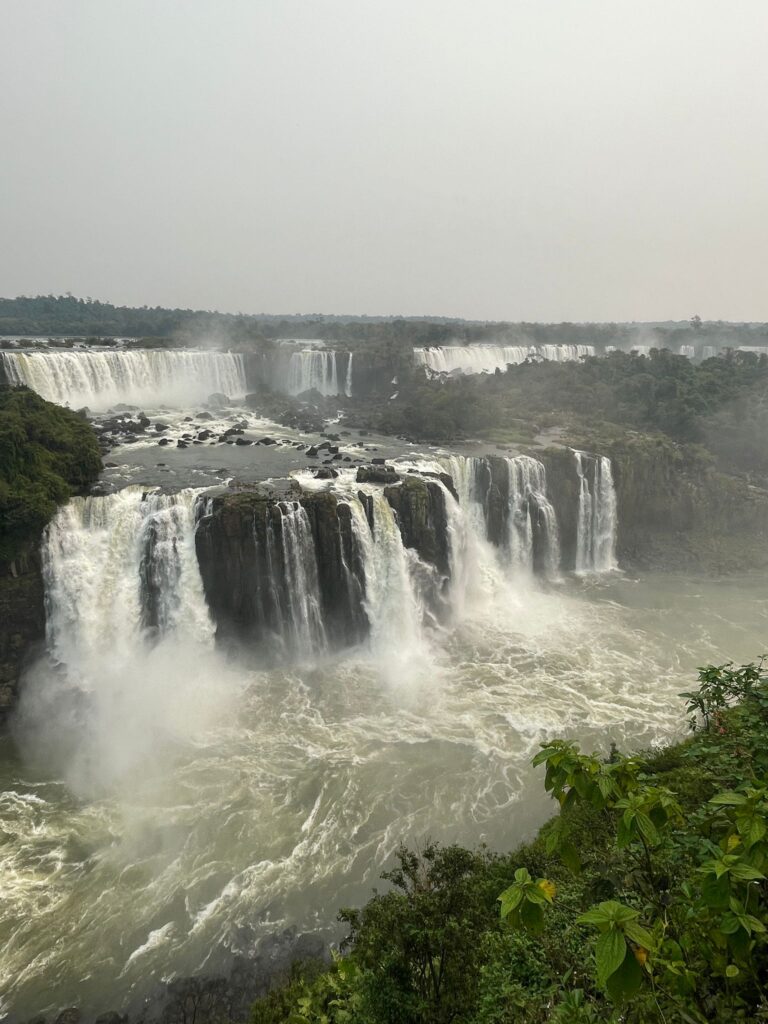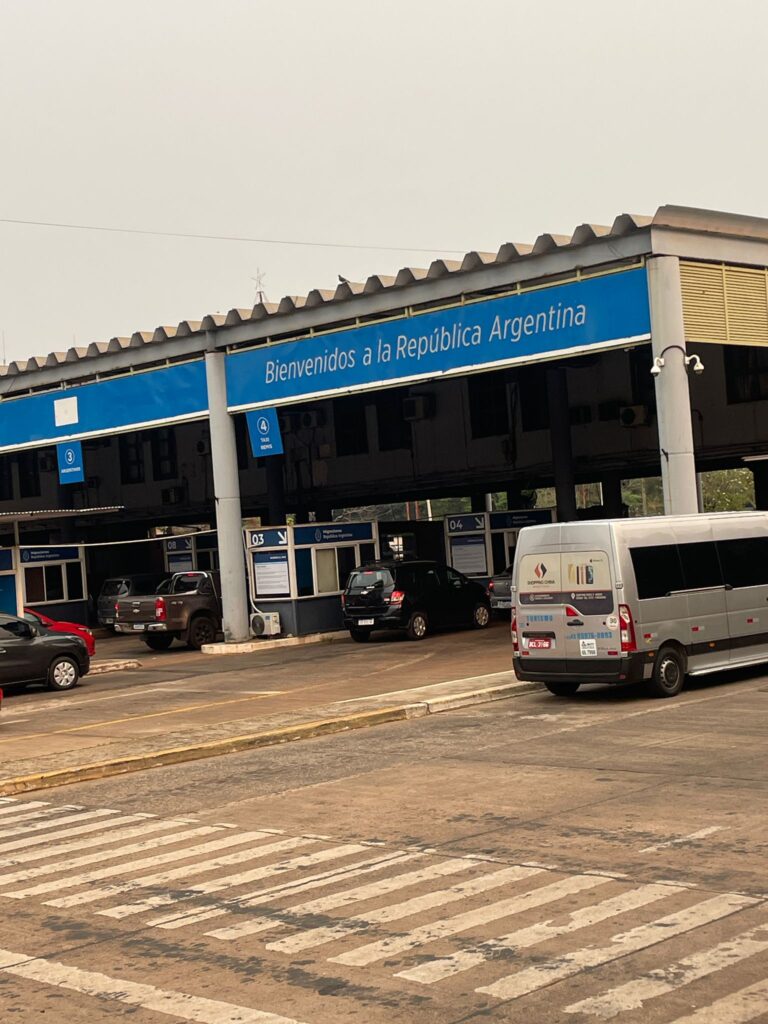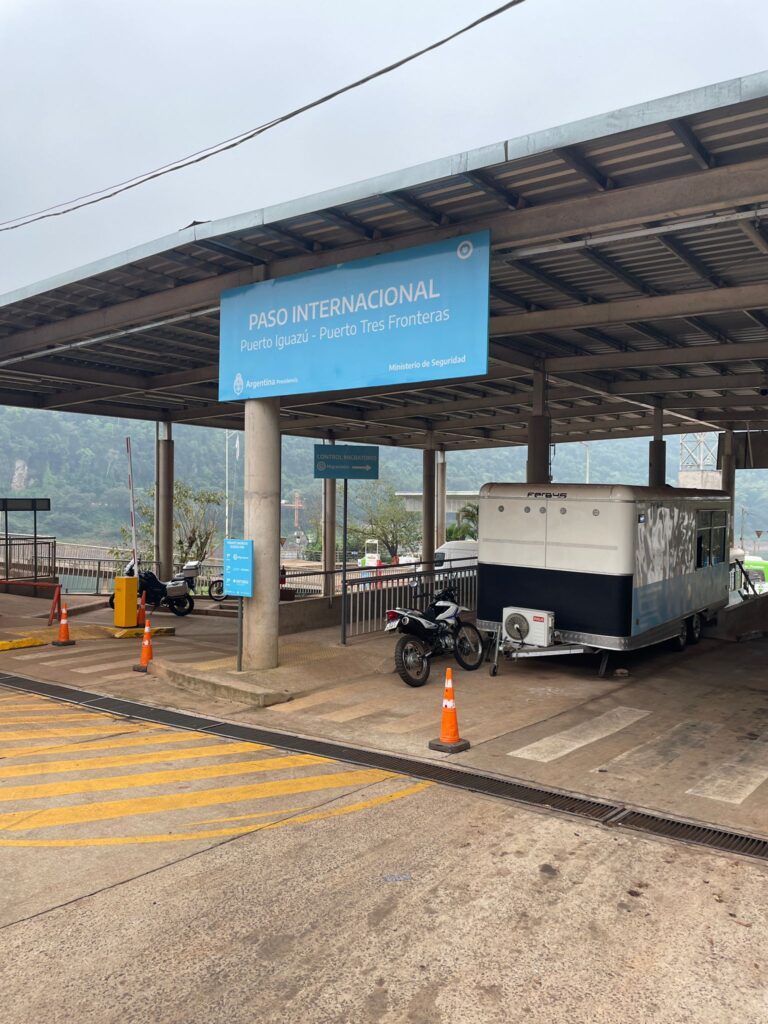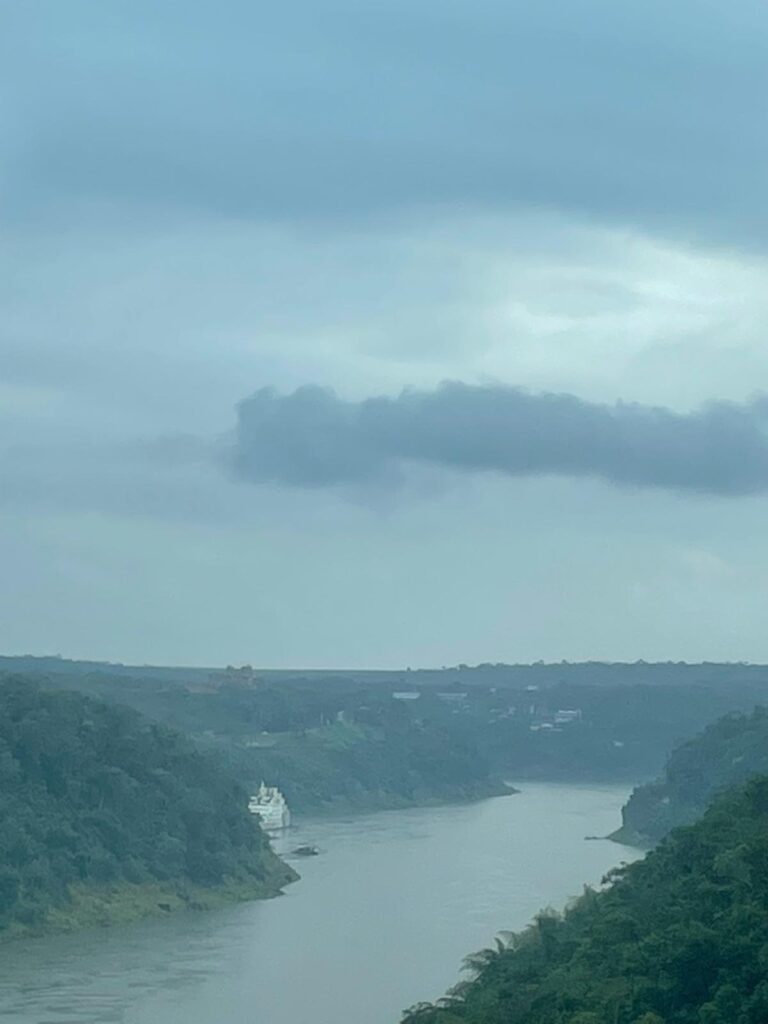Iguazu Falls Border Crossing: How to Cross the Triple Frontier Between Argentina, Brazil and Paraguay
Disclaimer: Some links on this page may be affiliate links. If you purchase anything through them, I will receive a small commission at no extra cost to you! Further details in the Privacy Policy.
I was surprised at how little information there was on the Iguazu Falls border crossing between Argentina and Brazil, as well as the additional crossing point into nearby Paraguay.
It’s a chaotic border region with a wild west feel to it, where you can get in serious trouble if you do things incorrectly (which is VERY easy to do here).
Thankfully I’ve crossed between the three countries at this point on no fewer than 9 occasions, and can share my tips with you on what you need to know if you don’t want to get arrested/fined/deported/all-of-the-above from a foreign country.
Read on to learn how to navigate this crazy part of South America, and avoid the many pitfalls it presents.

What is the Triple Frontier Border?
The Triple Frontier border is the region between Puerto Iguazu (Argentina), Foz do Iguacu (Brazil) and Ciudad del Este (Paraguay). It is popular amongst tourists visiting Iguazu Falls which can be seen on both the Brazil and Argentina sides of the Iguazu River.
Some tourists also head into Paraguay to visit the nearby Saltos del Monday waterfalls and civil engineering wonder, the Itaipu Dam, which can easily be accessed from Ciudad del Este. These incidentally should be on your Paraguay itinerary if you decide to spend time in this underrated country.
The Paraguayan city is also famous for cheap electronics, which makes it popular with Brazilians and Argentinians who cross in their thousands every single day.
How to Cross Between Puerto Iguazu and Foz do Iguacu
This is the most common leg of the journey, as most tourists will stick to visiting Iguazu Falls on both the Argentinian and Brazilian sides.
Crossing From Puerto Iguazu to Brazilian Iguazu Falls
If starting from Argentina, you will need to head to Puerto Iguazu Bus Terminal. From here, buy your tickets to the Brazilian falls. They should cost around £5/US$6 for a return ticket. I won’t list the price in Argentine pesos here as money in Argentina is so volatile that it changes in value on a regular basis.
The main companies selling tickets are Rio Uruguay and Crucero del Norte. Book in person as their websites are both pretty bad and don’t work properly. Buses generally leave hourly to the Brazilian falls from 7am with the last buses returning at 5pm. Staff generally speak English, so don’t worry about the language barrier here.
Your bus will always stop whilst entering or exiting Argentina. You will then need to go through immigration where your passport will be scanned. When entering Argentina, you will have to put your bags through a scanner. The process is very easy and doesn’t take long.
The Brazil border is where the problems start. BUSES DO NOT STOP AT THE BORDER UNLESS YOU SPECIFICALLY ASK THE DRIVERS TO.
And you MUST get stamped into Brazil, or you are in the country illegally. Read on a couple of sections to find out what could happen if you are caught.
At the terminal, ask your driver to stop at the Brazil border. Annoyingly most buses will drop you off and leave you at the border meaning you have to wait another hour for the next one even if you get through Brazilian immigration in a couple of minutes.
Argentina, Paraguay and Brazil are all members of Mercosur, a common market which allows free movement between the three countries (and Uruguay). Think of it as being South America’s version of the EU.
As almost everyone crossing the Triple Frontier border is a citizen of one of these countries, buses will not stop on the Brazil side unless you ask them to.
Crossing From Foz do Iguacu to Argentinian Iguazu Falls
If you start your journey in Brazil, you want to go to the Terminal de Transporte Urbano which is close to the Parana River that separates Paraguay and Brazil.
The station is pretty rugged if I’m honest. But if you look for any destination with “Puerto Iguazu” and/or “Argentina” listed as its destination, that’s the one you need.
The same rules apply at the border. Whilst everything runs smoothly during entry to Argentina, you MUST stop at the Brazil side, and ask the driver to do so. Once again, the driver probably won’t wait for you. Therefore you will annoyingly have to wait another hour for the next bus through to Argentina.
Even more irritatingly, buses from Brazil do not go directly to Iguazu Falls in Argentina. You will need to get off at Puerto Iguazu Bus Terminal and take any bus with “Cataratas” listed as the destination from there.
Therefore you will need a total of 6 buses to get to the Argentinian falls and back to Brazil. I strongly recommend staying in Puerto Iguazu for at least one night to see the falls from there.
Puerto Iguazu is a much smaller and calmer town than chaotic Foz do Iguacu. Argentina incidentally is one of Latin America’s safest countries, even with the economic crisis.
I would recommend reading all about safety in Argentina before your trip.
How Long Does the Crossing Take?
It depends on what time of day you go. The border crossing itself is very easy and will take less than 5 minutes if it’s quiet. This applies to both the Argentina and the Brazil side.
With heavy traffic it can take at least 30-60 minutes to cross the border.
Travelling from Puerto Iguazu Bus Terminal to Brazilian Iguazu Falls takes around 1.5 hours each way, including the border crossing.
Travelling from Terminal de Transporte Urbano to Argentinian Iguazu Falls will take around 2-3 hours each way, with changing buses at both the border and Puerto Iguazu Terminal accounting for much of that time.
What Happens if you Don’t get Stamped into or out of Argentina or Brazil?
You can get in big trouble with possible fines, deportation or bans from re-entering either country if you are found to have entered illegally.
In practice, it’s very hard to illegally enter Argentina at this border. However Brazil is a different story due to the buses not stopping.
I may or may not have crossed from Argentina to Brazil without being stamped into the Brazil side (wink wink). If this happens to you, make sure you get on the return bus at all costs and keep a low profile. No one comes onto the bus to check your documentation and drivers will not stop when they get back to the Brazil border. Therefore it’s easy to slip back into Argentina without Brazil ever knowing you were there.
The Argentinian officials don’t care if you were in Brazil illegally. You shouldn’t have any issues getting back in.
I would strongly advise ensuring you get your passport stamped in Brazil, even if it means having to wait for another bus to come along. You don’t want to have your trip to the falls ruined by stress related to the possibility of potential punishments for breaking immigration laws. Trust me on that one…

How to Cross Between Puerto Iguazu and Ciudad del Este
Crossing between Argentina and Paraguay by bus bypasses the Brazil border. Whilst buses will enter Brazilian territory, they will not stop and you do not need to get stamped in or out of Brazil as a result.
Once again, your journey from Argentina will start at Puerto Iguazu Bus Terminal, whereas you will end up in Ciudad del Este’s Terminal de Omnibus. Or vice versa.
Crossing from Puerto Iguazu to Ciudad del Este by Bus
Purchase a ticket from Puerto Iguazu Bus Terminal to the Paraguayan city. It will cost you £5/US$6 for a return ticket.
This crossing works just like the Argentina/Brazil one. Only you cut out the middleman (Brazil) and deal directly with Argentina and Paraguay.
Once again, Argentina will stamp you in and out of the country with no issues, and the bus will almost certainly stop at this border making the process easy. Yet the other country (in this case Paraguay) could cause you some issues.
One thing I’ve noticed is that people will often give you inaccurate information round here. We were told it was not necessary to be stamped into Brazil, and we were told it’s okay to visit Paraguay on a day trip without going through the correct process. Just because you might not get caught, it does not mean this is legal or the right thing to do.
You will need to ask the bus driver to stop at the Paraguay border to stamp you in. Once again, this means you may be left behind as the bus will not wait for you. If you’re lucky, there will be a queue of traffic at the busy Ciudad del Este (CDE) border and you will get through quicker than the bus which does mean you can reboard.
Paraguay is worth visiting, even if you only take a day to visit the Saltos del Monday waterfalls and Itaipu Dam. Although I would recommend at least a week in Paraguay. This way you can enjoy many activities in capital Asuncion, visit the beaches in San Bernardino and spend some time in Aregua too.
Want to plan a dream trip but you don’t have time? I can help you!
Experienced in travel to 70+ countries since January 2019 and helping clients plan the trip of a lifetime
✓ Make the most of your experience without spending hours planning
✓ Learn about budgeting, safety and more whilst travelling
Crossing from Ciudad del Este to Argentinian Iguazu Falls by Bus
To get from CDE to Argentinian Iguazu Falls, you will need to take a bus between the two terminals, and catch another from Puerto Iguazu Terminal to Iguazu Falls. Buses come hourly, on the hour throughout the day.
Again, you need to get stamped out of Paraguay, and the bus will not stop unless you ask. On some occasions they will wait for you to come back on here, as this border is absolutely wild and the traffic can be congested allowing you time to cross smoothly.
Crossing Between Ciudad del Este and Puerto Iguazu by Ferry
The ferry has finally reopened meaning you can go directly between Paraguay and Argentina without taking a bus through Brazil now. Sounds convenient right?
Well not quite. The ferry apparently runs hourly from 8:30am-3:30pm every day. Yet in practice it runs when boats are full, or simply when it wants to.
On the Argentina side, it isn’t obvious where to buy a ticket. You will need to speak to the staff controlling the border.
The Paraguay side is a bit dodgy, so I wouldn’t advise taking your heavy bags or valuables here. Also you will need to walk to the office so officials can stamp you into the country, otherwise you face potential problems when leaving.
Tickets cost £2/US$3 per person, £4/US$5 for a motorbike and £8/US$10 per car. But the buses are more reliable.

How Long Does the Crossing Take?
I would allow up to 3 hours for this journey. The majority of this time will be spent on the road taking you across Puente Internacional de la Amistad, the bridge connecting Paraguay and Brazil along the Parana River, due to traffic.
You may also experience congested roads in Foz do Iguacu which gets pretty crazy at times.
What Happens if you Don’t get Stamped into or out of Argentina or Paraguay?
Once again, you could be in big trouble and face large fines or deportation if you enter either country without passing through immigration correctly.
I have a story of a near miss for you. I crossed with my girlfriend from Encarnacion, a Paraguayan city best known for its easy access to the nearby Jesuit Missions, into Posadas, a small Argentinian border city, for a few hours.
On the way back, the bus did not stop at the Paraguay border. We noticed pretty quickly, spoke to the driver and got off ASAP before making a 20-second walk back to get stamped formally into Paraguay.
Paraguayan immigration took issue with this and threatened to call their higher-ups which would have left me with a probable fine of several hundred dollars for being in the country illegally.
Fortunately my girlfriend is Paraguayan and was able to talk calmly to the officials who soon backed down and let me in. But this could be a problem for you if you don’t get stamped into Paraguay correctly at any border crossing, including CDE.

How to Cross Between Foz do Iguacu and Ciudad del Este
The hardest border of all, for the sole reason that you have to get stamped in/out of both Paraguay and Brazil.
And, you guessed it, buses won’t wait for you here. You will need to get your driver to stop.
Crossing from Foz do Iguacu to Ciudad del Este
It’s pure chaos, but at least immigration control is within walking distance. Therefore if the bus leaves you behind as you get stamped out of Brazil, you can simply walk to Paraguay. Although you would need to wait for another bus if you wanted to get to the terminal (unless you fancied a long walk). The walk between border crossings will take around 5 minutes.
The process is pretty much the same as any other journey across the three borders. You should get on at the terminal, get your ticket and go. You can also get on at various points between the terminal and border, but I don’t recommend this.
You will need to ask the driver to stop the bus for you. Which means it is best to board at the terminal where the bus is stationary and you can talk to the driver without him rushing you on to get through as fast as possible.
Crossing from Ciudad del Este to Brazilian Iguazu Falls
You will firstly need to get a bus from Ciudad del Este to Foz do Iguacu. Then you will require a second bus from Foz to reach the cataratas, as they are known locally.
At the terminal in Foz, you should take the 120 bus to Foz do Iguacu International Airport. The bus will carry on from here straight to the Brazilian side of the falls. The airport is directly on route, so this won’t add much extra time to your journey.
How Long Does the Crossing Take?
You should allow 2-3 hours each way for this journey, with traffic at the border and a possible wait for the 120 bus potentially holding up your journey.
What Happens if you Don’t get Stamped into or out of Brazil or Paraguay?
Once again, failing to get stamped in or out of either country is illegal and you could get in a lot of trouble for it.
Because the border security situation is so lax, you can easily skip both borders and it is very unlikely that anyone would notice. I do not recommend this due to the risk of harsh punishments if caught.
Just make sure that whatever you do on the way in, you also do on the return journey. Therefore if you get stamped out of Brazil, also get stamped into Brazil. If you do NOT get stamped into Brazil, then stay on the bus when you cross back into the country to avoid punishment.
Likewise, you should either get stamped out of and back into Paraguay (recommended) or make sure you do not stop during both your exit from and entry into the country.
If you exit either country without officially re-entering, or you enter without formally exiting, this is where you are likely to have problems later down the line. It may be months before you are aware (if you stay in either country for months). By that time the punishments will be more severe.
Consistency is important here.

Do I Need a Visa to Cross the Triple Frontier Border Into Argentina, Brazil or Paraguay?
This depends on which country you are from, and complicates the border crossing if you do require a visa.
Good news for fellow Brits. We can enter all three countries for up to 90 days without a visa. It’s easy for us. The same rules apply to EU citizens.
I have bad news for Americans however. Americans require a visa for Brazil from April 10th 2025. The same applies to Australians and Canadians.
Whilst the visa is valid for 10 years, it can cause problems from April 2035 onwards if you enter Brazil with a valid visa and it expires whilst you are in the country. Keep an eye out for rule changes as the visa is currently set to allow multiple entries into the country, but rules may change.
If you require a visa, it may be tempting to cross into Brazil illegally to save yourself the hassle. I do not recommend this at all due to the risk of harsh punishments and heavy fines. Although the chances of being caught are low assuming you return to Argentina/Paraguay via the same border crossing.
Just be careful, as one mistake can mess up your entire South America itinerary if you are unable to re-enter countries.
More Posts on Paraguay
- The 17 Best Cities In South America To Visit In 2025
- The Safest Countries In South America In 2025: Ranked
- Best Countries In South America To Travel To: Ranked
- The 15 Most Underrated Countries To Visit In 2025
- What Are The Best South American Countries For First Timers?
- What Are The 10 Safest Cities In South America In 2025?
- The Ultimate 6 Month South America Itinerary On A Budget
- Salta To Asuncion By Bus (Clorinda/Jose Falcon Border)
- 7 Day Paraguay Itinerary: From Asuncion To Ciudad Del Este
- Iguazu Falls Border Crossing: How To Cross The Triple Frontier Between Argentina, Brazil And Paraguay
- 6 Best Restaurants In Asuncion Paraguay: All-You-Can-Eat Delights
- Helpful Information On Visiting The Jesuit Missions In Paraguay
- 19 Best Things To Do In Asuncion, Paraguay
- Is Paraguay Worth Visiting? South America’s Hidden Gem
- Is Paraguay Safe For Tourists To Visit?
- When Is The Best Time To Visit Paraguay?
- Everything You Should Know Before Visiting San Bernardino, Paraguay
- Visiting Aregua In Paraguay: The Home Of The Strawberry Expo
- Bus Transport In Asuncion: How To Get Around Paraguay’s Capital
- Safest Latin American Countries To Visit In 2025
More Posts on Argentina
- The 17 Best Cities In South America To Visit In 2025
- The Safest Countries In South America In 2025: Ranked
- Best Countries In South America To Travel To: Ranked
- The Best Things To Do In Buenos Aires: A 3-Day Itinerary
- Buenos Aires Vs Rio De Janeiro: Which Is Better To Visit?
- What Are The Best South American Countries For First Timers?
- What Are The 10 Safest Cities In South America In 2025?
- The Ultimate 6 Month South America Itinerary On A Budget
- Planning The Perfect Day Trip To Colonia From Buenos Aires
- Is Argentina Safe For Tourists To Travel To?
- Salta To Asuncion By Bus (Clorinda/Jose Falcon Border)
- How To Get From Salta To Uyuni By Bus (La Quiaca/Villazon)
- Where To See Penguins In Argentina On A Budget: Punta Tombo
- One Day In Buenos Aires: The Perfect 24-Hour Itinerary
- A 2 Week Patagonia Itinerary: From Ushuaia To Bariloche
- Best Things To Do In Ushuaia: Don’t Miss Out On This Gem!
- Cafe Tortoni: What To Expect In The Famous Buenos Aires Cafe
- Iguazu Falls Border Crossing: How To Cross The Triple Frontier Between Argentina, Brazil And Paraguay
- The Ultimate Guide To Visiting Iguazu Falls (Argentina Side)
- Money In Argentina: How To Get The Best Rates In 2024
- A 3-Week Argentina Itinerary: From Mendoza To Buenos Aires
- What To Do In Villa General Belgrano?
- How To Order Steak In Argentina
- Top 5 Things To Do In La Boca, Buenos Aires
- Safest Latin American Countries To Visit In 2025
More Posts on Brazil
- The 17 Best Cities In South America To Visit In 2025
- The Safest Countries In South America In 2025: Ranked
- Best Countries In South America To Travel To: Ranked
- Buenos Aires Vs Rio De Janeiro: Which Is Better To Visit?
- What Are The Best Things To Do In Rio De Janeiro?
- How To Get From Cayenne To Belem On A Budget
- The Ultimate 6 Month South America Itinerary On A Budget
- Iguazu Falls Border Crossing: How To Cross The Triple Frontier Between Argentina, Brazil And Paraguay
